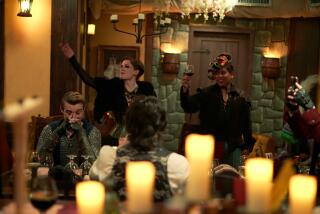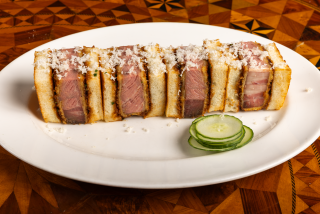Opened in 1880s, Survived Prohibition : Saloon Served Up Games to Stay Afloat
- Share via
COLUMBUS, Neb. — Glur’s Tavern may be the oldest saloon west of the Missouri River, but it was during the dry days of Prohibition that the place took on the flavor that helped make it a national landmark.
In the 1920s, when a tavern keeper couldn’t sell anything stronger than root beer, Louis Glur introduced decks of cards, cribbage boards and slot machines with drink-token payoffs in a frantic effort to keep showing his sober customers a good time.
“He was trying to fill in the gap left by the beer,” said Gus Viergutz, who married Glur’s eldest daughter, Elinor, and ended up running Glur’s Tavern for nearly a decade.
The games gimmick worked so well that it is still the trademark of what has become a local institution and national historic site, even though more liquid forms of gusto have long since returned to the tavern’s heavy old unfinished wooden tables.
“The farmers have to have a place to play cards,” Viergutz said.
They begin filing into the barroom, which has a scuffed hardwood floor, long before noon in their seed-corn hats and work clothes. They grab the cards and coffee cans full of chips from behind the bar and deal up serious games of pinochle, euchre, sheepshead and dirty spades. The games are so serious that the players don’t even drink much.
“They’ll sit there all day if you let them,” Viergutz said. “I used to get so mad trying to kick them out.”
Glur’s owes its “oldest in the West” designation to a contest some years back sponsored by Beverage Analyst magazine. Not counting Prohibition, the place has been a saloon since 1879, when William Bucher started the business here in eastern Nebraska.
There have been a couple of half-hearted challenges to the title. But local people don’t acknowledge any serious contenders. And in 1975, the two-story frame building entered the National Register of Historic Sites.
“It’s authentic, there’s no question about it,” said Viergutz, who knows as much of the voluminous local folklore surrounding the place as anyone in town.
Buying a Round
Buffalo Bill is supposed to have dropped in sometime during the 1880s--nobody’s quite sure when--and astonished the crowd by offering to buy a round with a $1,000 bill. Bucher is said to have fainted dead away behind the bar, presumably at the thought of having to make change.
A teen-age Louis Glur hired on as an employee in 1903 and bought the place a decade later when Bucher decided to stop making small loans from the back of the barroom and go into the banking business in earnest.
The Glur family continued as owners until 1977, when Elinor and Gus Viergutz, who was also running a family lumberyard, sold out to two Columbus men, Roger Brown and Brian Gaver.
“We were tired,” Elinor Viergutz said. “We wouldn’t get out of there till 3 o’clock in the morning.”
The card players tend to dominate the daytime trade. But in the evenings, a crowd of young couples, students and families with small children moves in, spilling out into a beer garden that has equipment for volleyball and horseshoes. The kids even have a sandbox.
“It’s always been a place where you could take your kids,” Elinor Viergutz said.
Well, not always. Even women hardly ever went inside in the old days. Until the 1960s, the only ladies’ room was an outdoor privy next to the beer garden.
“In the winter, we women would have to go out through the cold and snow to go to the bathroom,” she said. “They had it shoveled, but it was pretty cold out there.”
The Viergutzes are old enough to remember the old gaslights that once adorned the beer garden, the livery stable that used to be across the street and the graceful trees out back, cut down decades ago because of Dutch elm disease.
More to Read
Sign up for Essential California
The most important California stories and recommendations in your inbox every morning.
You may occasionally receive promotional content from the Los Angeles Times.












